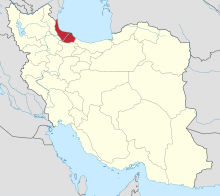Gilan Province
Gilan Province (Persian: استان گیلان, Ostān-e Gīlān),[9] is one of the 31 provinces of Iran. It lies along the Caspian Sea, in Iran's Region 3, west of the province of Mazandaran, east of the province of Ardabil, and north of the provinces of Zanjan and Qazvin.[10] It borders the Republic of Azerbaijan in the north and Russia across the Caspian Sea.
Gilan Province استان گیلان | |
|---|---|
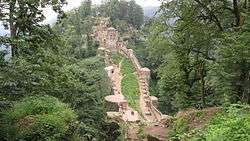 Rudkhan Castle | |
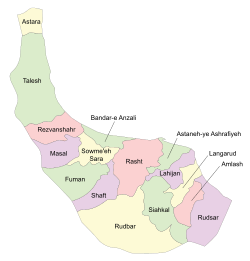 Counties of Gilan Province | |
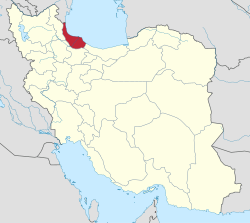 Location of Gilan Province in Iran | |
| Coordinates: 37.2774°N 49.5890°E | |
| Country | |
| Region | Region 3 |
| Capital | Rasht |
| Counties | 16 |
| Area | |
| • Total | 14,042 km2 (5,422 sq mi) |
| Population (2016)[1] | |
| • Total | 2,530,696 |
| • Density | 180/km2 (470/sq mi) |
| Time zone | UTC+03:30 (IRST) |
| • Summer (DST) | UTC+04:30 (IRST) |
| Area code(s) | 013 |
| Main language(s) | Gilaki Talyshi |
| Others(s) | Persian[2] Kurdish |
| Website | https://www.gilan.ir/ |
The northern part of the province is part of territory of South (Iranian) Talysh. At the center of the province is the main city of Rasht. Other towns in the province include Astara, Astaneh-e Ashrafiyyeh, Fuman, Lahijan, Langarud, Masouleh, Manjil, Rudbar, Rudsar, Shaft, Hashtpar, and Sowme'eh Sara.
The main harbor port is Bandar-e Anzali (previously Bandar-e Pahlavi).
History
In antiquity, this area was a province of Persia known as Daylam (sometimes Daylaman, Dailam or Delam). The Daylam region corresponds to the modern region of Gīlān.[11]
Early history
It seems that the Gelae (Gilites) entered the region south of the Caspian coast and west of the Amardos River (later Safidrud) in the second or first century B.C.E. Pliny identifies them with the Cadusii who were living there previously. It is more likely that they were a separate people, had come from the region of Dagestan, and taken the place of the Kadusii. That the native inhabitants of Gilan have originating roots in the Caucasus is supported by genetics and language, as Gilaks are genetically closer to ethnic peoples of the Caucasus (such as the Georgians) than they are towards other ethnic groups in Iran.[12] Their languages shares typologic features with Caucasian languages.[13]
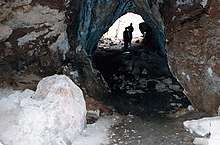
Medieval history
Gilan Province was the place of origin of the Buyid dynasty in the mid-10th century. Previously, the people of the province had a prominent position during the Sassanid dynasty through the 7th century, so that their political power extended to Mesopotamia.
The first recorded encounter between Gilanis and Deylamite warlords and invading Muslim Arab armies was at the Battle of Jalula in 637 AD. Deylamite commander Muta led an army of Gils, Deylamites, Persians and people of the Rey region. Muta was killed in the battle, and his defeated army managed to retreat in an orderly manner.
However, this appears to have been a Pyrrhic victory for the Arabs, since they did not pursue their opponents. Unlike the Rus', Muslim Arabs never managed to conquer Gilan as they did with other provinces in Iran. Gilanis and Deylamites successfully repulsed all Arab attempts to occupy their land or to convert them to Islam. In fact, it was the Deylamites under the Buyid king Mu'izz al-Dawla who finally shifted the balance of power by conquering Baghdad in 945. Mu'izz al-Dawla, however, allowed the Abbasid caliphs to remain in comfortable, secluded captivity in their palaces.[14]
The Church of the East began evangelizing Gilan in the 780s, when a metropolitan bishopric was established under Shubhalishoʿ.[15] In the 9th and 10th centuries AD, Deylamites and later Gilanis gradually converted to Zaidite Shi'ism. Several Deylamite commanders and soldiers of fortune who were active in the military theaters of Iran and Mesopotamia were openly Zoroastrian (for example, Asfar Shiruyeh a warlord in central Iran, and Makan, son of Kaki, the warlord of Rey) or were suspected of harboring pro-Zoroastrian (for example Mardavij) sentiments. Muslim chronicles of Varangian (Rus', pre-Russian Norsemen) invasions of the littoral Caspian region in the 9th century record Deylamites as non-Muslim. These chronicles also show that the Deylamites were the only warriors in the Caspian region who could fight the fearsome Varangian vikings as equals. Deylamite mercenaries served as far away as Egypt, Islamic Spain, and in the Khazar Kingdom.
The Buyids established the most successful of the Deylamite dynasties of Iran.
_4.jpg)
In the 9th–11th century AD, there were repeated military raids undertaken by the Rus' between 864 and 1041 on the Caspian Sea shores of Iran, Azerbaijan, and Dagestan as part of the Caspian expeditions of the Rus'.[16] Initially, the Rus' appeared in Serkland in the 9th century traveling as merchants along the Volga trade route, selling furs, honey, and slaves. The first small-scale raids took place in the late 9th and early 10th century. The Rus' undertook the first large-scale expedition in 913; having arrived on 500 ships, they pillaged the westernmost parts of Gorgan as well as Gilan and Mazandaran, taking slaves and goods.
The Turkish invasions of the 10th and 11th centuries CE, which saw the rise of Ghaznavid and Seljuk dynasties, put an end to Deylamite states in Iran. From the 11th century CE to the rise of Safavids, Gilan was ruled by local rulers who paid tribute to the dominant power south of the Alborz range but ruled independently.
In 1307 the Ilkhan Öljeitü conquered the region.[17] This was the first time the region came under the rule of the Mongols after the Ilkhanid Mongols and their Georgian allies failed to do it in the late 1270s.[18] After 1336, the region seemed to be independent again.
Before the introduction of silk production (date unknown but a pillar of the economy by the 15th century AD), Gilan was a poor province. There were no permanent trade routes linking Gilan to Persia. There was a small trade in smoked fish and wood products. It seems that the city of Qazvin was initially a fortress-town against marauding bands of Deylamites, another sign that the economy of the province did not produce enough on its own to support its population. This changed with the introduction of the silk worm in the late Middle Ages.
Early modern and modern history
Gilan recognized twice, for brief periods, the suzerainty of the Ottoman Empire without rendering tribute to the Sublime Porte, in 1534 and 1591.[19]
The Safavid emperor, Shah Abbas I ended the rule of Khan Ahmad Khan (the last semi-independent ruler of Gilan) and annexed the province directly to his empire. From this point onward, rulers of Gilan were appointed by the Persian Shah. In the Safavid era, Gilan was settled by large numbers of Georgians, Circassians, Armenians, and other peoples of the Caucasus whose descendants still live or linger across Gilan. Most of these Georgians and Circassians are assimilated into the mainstream Gilaks. The history of Georgian settlement is described by Iskandar Beg Munshi, the author of the 17th century Tarikh-e Alam-Ara-ye Abbasi, and the Circassian settlements by Pietro Della Valle, among other authors.[20]
The Safavid empire became weak towards the end of the 17th century CE. By the early 18th century, the once-mighty empire was in the grips of civil war and uprisings. The ambitious Peter I of Russia (Peter the Great) sent a force that captured Gilan and many of the Iranian territories in the North Caucasus, Transcaucasia, as well as other territories in northern mainland Iran, through the Russo-Persian War (1722-1723) and the resulting Treaty of Saint Petersburg (1723).[21] Gilan and its capital of Rasht, which was conquered between late 1722 and late March 1723, stayed in Russian possession for about ten years.[22]
Qajars established a central government in Persia (Iran) in the late 18th century CE. They lost a series of wars to Russia (Russo-Persian Wars 1804–1813 and 1826–28), resulting in an enormous gain of influence by the Russian Empire in the Caspian region, which would last up to 1946. The Gilanian cities of Rasht and Anzali were all but occupied and settled by Russians and Russian forces. Most major cities in the region had Russian schools and significant traces of Russian culture can be found today in Rasht. Russian class was mandatory in schools and the significant increase of Russian influence in the region lasted until 1946 and had a major impact on Iranian history, as it directly led to the Persian Constitutional Revolution.
Gilan was a major producer of silk beginning in the 15th century CE. As a result, it was one of the wealthiest provinces in Iran. Safavid annexation in the 16th century was at least partially motivated by this revenue stream. The silk trade, though not the production, was a monopoly of the Crown and the single most important source of trade revenue for the imperial treasury. As early as the 16th century and until the mid 19th century, Gilan was the major exporter of silk in Asia. The Shah farmed out this trade to Greek and Armenian merchants and, in return, received a handsome portion of the proceeds.
In the mid-19th century, a fatal epidemic among the silk worms paralyzed Gilan's economy, causing widespread economic distress. Gilan's budding industrialists and merchants were increasingly dissatisfied with the weak and ineffective rule of the Qajars. Re-orientation of Gilan's agriculture and industry from silk to production of rice and the introduction of tea plantations were a partial answer to the decline of silk in the province.
After World War I, Gilan came to be ruled independently of the central government of Tehran and concern arose that the province might permanently separate. Before the war, Gilanis had played an important role in the Constitutional Revolution of Iran. Sepahdar-e Tonekaboni (Rashti) was a prominent figure in the early years of the revolution and was instrumental in defeating Mohammad Ali Shah Qajar.
In the late 1910s, many Gilanis gathered under the leadership of Mirza Kuchik Khan, who became the most prominent revolutionary leader in northern Iran in this period. Khan's movement, known as the Jangal movement of Gilan, had sent an armed brigade to Tehran that helped depose the Qajar ruler Mohammad Ali Shah. However, the revolution did not progress the way the constitutionalists had strived for, and Iran came to face much internal unrest and foreign intervention, particularly from the British and Russian empires.
During and several years after the Bolshevik Revolution, the region saw another massive influx of Russian settlers (the so-called White émigrées). Many of the descendants of these refugees are in the region. During the same period, Anzali served as the main trading port between Iran and Europe.
The Jangalis are glorified in Iranian history and effectively secured Gilan and Mazandaran against foreign invasions. However, in 1920 British forces invaded Bandar-e Anzali, while being pursued by the Bolsheviks. In the midst of this conflict, the Jangalis entered into an alliance with the Bolsheviks against the British. This culminated in the establishment of the Persian Socialist Soviet Republic (commonly known as the Socialist Republic of Gilan), which lasted from June 1920 until September 1921.
In February 1921 the Soviets withdrew their support for the Jangali government of Gilan and signed the Russo-Persian Treaty of Friendship (1921) with the central government of Tehran. The Jangalis continued to struggle against the central government until their final defeat in September 1921 when control of Gilan returned to Tehran.
Gilan was one of all the provinces that participated in the 2017-18 Iranian protests.
Administrative divisions
| Map | Abbreviation in map | County (Shahrestan) |
|---|---|---|
| AS | Astara | |
| AA | Astaneh Ashrafiyeh | |
| BA | Bandar-e Anzali | |
| FM | Fuman | |
| RZ | Rezvanshahr | |
| LH | Lahijan | |
| LR | Langarud | |
| RT | Rasht | |
| RS | Rudsar | |
| RB | Rudbar | |
| SS | Sowme'eh Sara | |
| SH | Shaft | |
| MS | Masal | |
| TL | Talesh/hashtpar | |
| SK | Siahkal | |
Geography and climate

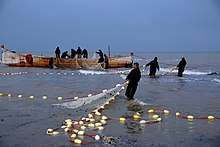
.jpg)
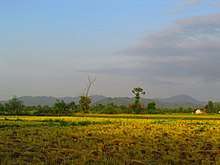
Gilan has a humid subtropical climate with, by a large margin, the heaviest rainfall in Iran: reaching as high as 1,900 millimetres (75 in) in the southwestern coast and generally around 1,400 millimetres (55 in). Rasht, the capital of the province, is known internationally as the "City of Silver Rains" and in Iran as the "City of Rain".
Rainfall is heaviest between September and December because the onshore winds from the Siberian High are strongest, but it occurs throughout the year though least abundantly from April to August. Humidity is very high because of the marshy character of the coastal plains and can reach 90 percent in summer for wet bulb temperatures of over 26 °C (79 °F). The Alborz range provides further diversity to the land in addition to the Caspian coasts.
The coastline is cooler and attracts large numbers of domestic and international tourists. Large parts of the province are mountainous, green and forested. The coastal plain along the Caspian Sea is similar to that of Mazandaran and mainly used for rice paddies. Due to successive cultivation and selection of rice by farmers, several cultivars including Gerdeh, Hashemi, Hasani, and Gharib have been bred.[23]
In June 1990 large parts of the province were destroyed by a severe earthquake, in which about 45,000 people died. Abbas Kiarostami made his films Life, and Nothing More... and Through the Olive Trees based on this event.
Demographics
Gilan is overwhelmingly Gilak and Talesh, with a minority of persians and smaller groups of Georgians, Armenians, Circassians and others.
Five Iranian languages are spoken in Gilan — Gilaki, Taleshi, Persian, and, to a smaller extent, Tati and Kurdish. All (excluding Persian) belong to the northwestern branch of Iranian languages. Non-Iranian languages are mainly Georgian, Armenian, Circassian, and some Gypsy (Romany). Three million people speak Gilaki as first or second language.
| Year | 1996 | 2006 | 2011 | 2016 [24] |
|---|---|---|---|---|
| Approximate population | 2,241,896 | 2,404,861 | 2,480,874 | 2,530,696 |
Culture
.jpg)
.jpg)
Considering Gilan is mostly inhabited by Gilaks, a Gilaki Iranian culture is present in the province that is not much different from other Iranian traditions. The biggest differences are seen in foods, traditional songs, traditional clothes, rural areas and their every-day life, and other traditions such as the Gilaki Calendar and the Gilaki New Year called "Nouruz Bel" which is during the summer. This new year is distinct from the more popular Iranian New Year as it relates to the people of Gilan and their mostly agricultural life.
Gilan's position on the Tehran-Baku trade route has established the cities of Bandar-e Anzali and Rasht as ranking amongst the most important commercial centers in Iran. As a result, the merchant and middle classes comprise a significant percentage of the population.
The province has an annual average of 2 million tourists, mostly domestic. Although Iran's Cultural Heritage Organization lists 211 sites of historical and cultural significance in the province, the main tourist attraction in Gilan is the small town of Masouleh in the hills southeast of Rasht. It is built similar to the Pueblo settlements, with the roof of one house being the courtyard of the house above.
Gilan has a strong culinary tradition, from which several dishes have come to be adopted across Iran. This richness derives in part from the climate, which allows for a wide variety of fruit, vegetables and nuts to be grown in the province. Seafood is a particularly strong component of Gilani (and Mazandarani) cuisine. Sturgeon, often smoked or served as kebab, and caviar are delicacies along the whole Caspian littoral. Other types of fish such as mahi sefid, kuli, kulmeh, Caspian salmon, mahi kapur and many others are consumed. Fish roe, or ashpal, is widely used in Gileki cuisine. Traditional Persian stews such as ghalieh mahi (fish stew) and ghalieh maygu (shrimp stew) are featured and prepared in a uniquely Gilani fashion.
More specific to Gilan are a distinctive walnut-paste and pomegranate-juice sauce, used as a marinade for 'sour' kebab (Kabab Torsh) and as the basis of Fesenjān, a rich stew of duck, chicken or lamb. Mirza ghasemi is an aubergine and egg dish with a smoky taste that is often served as a side dish or appetizer. Other such dishes include pickled garlic, olives with walnut paste, and smoked fish. The caviar and smoked fish from the region are widely prized and sought-after specialties in domestic and foreign gourmet markets. See also Cuisine of Iran.
Languages
The Gilaki language is a Caspian language, and a member of the northwestern Iranian language branch, spoken in Iran's Gīlān Province.[25][26] Gilaki is one of the main languages spoken in the province of Gilan and is divided into three dialects: Western Gilaki, Eastern Gilaki, and Galeshi (in the mountains of Gilan). The western and eastern dialects are separated by the Sefid Roud.[27] Although Gilaki is the most widely spoken language in Gilan, the Talysh language is also spoken in the province. There are only two cities in Gilan where Talyshi is exclusively spoken: Masal and Masoleh (although other cities speak Talyshi alongside Gilaki) while Talyshi is spoken mostly in the city of Astara, Hashtpar and surrounding towns.
Persian[28] is also spoken in the province of Gilan as it is Iran's official language, requiring everyone to know Persian.
Notable people
- Abdul Qadir Gilani
- Haj Agha Koutchesfahani (founder of Rasth Telephone Company )
- Ebrahim Pourdavoud
- Mohammad Ali Mojtahedi Gilani, founder of Sharif University of Technology
- Ardeshir Mohassess, cartoonist
- Mirza Kuchek Khan, founder of Constitutionalist movement of Gilan
- Arsen Minasian
- Hazin Lahiji, poet
- Mohammad Taghi Bahjat Foumani, Twelver Shi'a Marja
- Al-Jilani
- Mahmoud Behzad
- Majid Samii, brain surgeon in Germany
- Fazlollah Reza, second head of Sharif University of Technology
- Mohammad Moin, prominent Iranian scholar of Persian literature and Iranology
- Sirous Ghayeghran, former captain of Iranian national football team
- Ghafour Jahani, footballer
- Pejman Nouri, football player
- Hushang Ebtehaj, contemporary poet
- Mardavij, former king of Iran
- Khosrow Golsorkhi, journalist, poet, and communist activist
- Abul-Hasan Kūshyār ibn Labbān ibn Bashahri Gilani, mathematician, geographer, and astronomer
- Anoushiravan Rohani, pianist and composer
- Shardad Rohani, composer, violinist/pianist, and conductor
- Shahin Najafi, musician, singer, songwriter and political activist
Colleges and universities
- University of Guilan
- Islamic Azad University of Astara
- Islamic Azad University of Bandar Anzali
- Islamic Azad University of Rasht
- Islamic Azad University of Lahijan
- Gilan University of Medical Sciences
- Institute of Higher Education for Academic Jihad of Rasht
- Technical & Vocational Training Organization of Gilan
- Islamic Azad University of Talesh
- Payam-e-Noor University – Talesh
See also
- Biah Pish
- Constitutionalist movement of Gilan
- Soviet Republic of Gilan
- Gill (clan)
- Gilani people
- Rudkhan Castle
- Aroos-Gooleh
References
- Selected Findings of National Population and Housing Census 2011 Archived 31 May 2013 at the Wayback Machine
- Guilan Government Province website Archived 11 December 2011 at the Wayback Machine
- library Great Encyclopedia of Islam – Astara
- Encyclopædia Iranica:Manjil Archived 17 May 2013 at the Wayback Machine
- "Archived copy". Archived from the original on 20 March 2015. Retrieved 18 March 2015.CS1 maint: archived copy as title (link)
- "Archived copy". Archived from the original on 3 December 2013. Retrieved 12 August 2013.CS1 maint: archived copy as title (link)
- "HugeDomains.com - TalesHan.com is for sale (Tales Han)". www.taleshan.com. Archived from the original on 24 September 2015. Retrieved 28 April 2018.
- "Archived copy". Archived from the original on 21 July 2013. Retrieved 12 August 2013.CS1 maint: archived copy as title (link)
- Archived 17 July 2013 at the Wayback Machine University of Guilán
- "همشهری آنلاین-استانهای کشور به ۵ منطقه تقسیم شدند (Provinces were divided into 5 regions)". Hamshahri Online (in Persian). 22 June 2014 (1 Tir 1393, Jalaali). Archived from the original on 23 June 2014. Check date values in:
|date=(help) - The Places Where Men Pray Together, Paul Wheatley P166
- Nasidze, Ivan; Quinque, Dominique; Rahmani, Manijeh; Alemohamad, Seyed Ali; Stoneking, Mark (2006). "Concomitant Replacement of Language and mtDNA in South Caspian Populations of Iran". Current Biology. 16 (7): 668–673. doi:10.1016/j.cub.2006.02.021. PMID 16581511.
- The Tati language group in the sociolinguistic context of Northwestern Iran and Transcaucasia, D. Stilo, pages 137–185
- http://original.britannica.com/eb/article-22885/Iraq#147477.hook%5B%5D
- David Wilmshurst (2011), The Martyred Church: A History of the Church of the East, East and West Publishing, p. 166.
- Logan (1992), p. 201
- Charles Melville – “The Ilkhan Öljeitü's conquest of Gilan (1307): rumour and reality”, in R. Amitai Preiss & D.O. Morgan (eds), The Mongol empire and its legacy, Leiden 1999, pp. 73–125
- "Archived copy". Archived from the original on 6 April 2012. Retrieved 23 November 2011.CS1 maint: archived copy as title (link)
- Donald Edgar Pitcher (1968). An Historical Geography of the Ottoman Empire: From Earliest Times to the End of the Sixteenth Century. Brill Archive. p. 132. Archived from the original on 28 April 2018.
- Pietro Della Valle, Viaggi, 3 vols. in 4 parts, Rome, 1658–63; tr. J. Pinkerton as Travels in Persia, London, 1811.
- William Bayne Fisher, P. Avery, G. R. G. Hambly, C. Melville. The Cambridge History of Iran, Volume 7 Cambridge University Press, 10 okt. 1991 ISBN 0521200954 p 321
- The Caucasus in the System of International Relations: The Turkmanchay Treaty Was Signed 180 Years Ago Научная библиотека КиберЛенинка Archived 29 June 2015 at the Wayback Machine p 142
- Pazuki, Arman & Sohani, Mehdi (2013). "Phenotypic evaluation of scutellum-derived calluses in 'Indica' rice cultivars". Acta Agriculturae Slovenica. 101 (2): 239–247. doi:10.2478/acas-2013-0020.
- "IRAN: Gilan". Archived from the original on 29 July 2020. Retrieved 21 May 2014.
- ^ Coon, "Iran:Demography and Ethnography" in Encyclopedia of Islam, Volume IV, E.J. Brill, pp. 10,8. Excerpt: "The Lurs speak an aberrant form of Archaic Persian" See maps also on page 10 for distribution of Persian languages and dialect
- Kathryn M. Coughlin, "Muslim cultures today: a reference guide," Greenwood Publishing Group, 2006. p. 89: "...Iranians speak Persian or a Persian dialect such as Gilaki or Mazandarani."
- Leipzig, Max Planck Institute for Evolutionary Anthropology. "Former Dept. of Linguistics - Northwest Iranian Project". www.eva.mpg.de. Archived from the original on 9 December 2017. Retrieved 28 April 2018.
- "Archived copy". Archived from the original on 11 December 2011. Retrieved 3 December 2011.CS1 maint: archived copy as title (link)
External links
- Guilan.net
- Association of Guilan Supporters Official website (in Persian only)
- Gilan entry in the Encyclopædia Iranica
- Gilan University of Medical Sciences Health Information Center (in English)
- Gilan Cultural Heritage Organization (An excellent source of info in Persian)
- Masouleh Village Official website (inaccessible to English readers)
- Shapour Bahrami, Masouleh, Iran, Photo Set, flickr.
- Gilan Province Office of Tourism
- Houchang E. Chehabi (ed.). "Regional Studies: Gilan". Bibliographia Iranica. USA: Iranian Studies Group at MIT. (Bibliography)
- Gilan Province Department of Education (in Persian)
- Two Gilani folk-songs sung by Shusha Guppy in the 1970s: The Rain, Darling Leila.
- Āhā Bugu (Oh, say it!), a Gilaki folk-song: Video on YouTube (4 min 54 sec).
- Pazuki, Arman & Sohani, Mehdi (2013). "Phenotypic evaluation of scutellum-derived calluses in 'Indica' rice cultivars". Acta Agriculturae Slovenica. 101 (2): 239–247. doi:10.2478/acas-2013-0020.
- Hamid-Reza Hosseini, Rural Heritage, in Persian, Jadid Online, 17 November 2008, .
A shortened version in English with the title Gilan's Rural Geritage Museum, Jadid Online, 22 January 2009: .
A slide show of Gilan's Rural Heritage Museum with English subtitles, Jadid Online, 22 January 2009: (5 min 41 sec). - Mohammad-Taqi Pourahmad Jacktaji, Gilan Midsummer Nowruz, in English, Jadid Online, 1 October 2009, (in Persian: ).
An audio slideshow with English subtitles: (4 min 38 sec).
